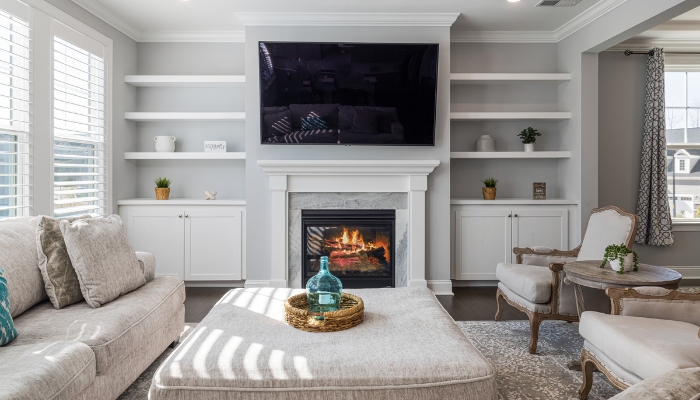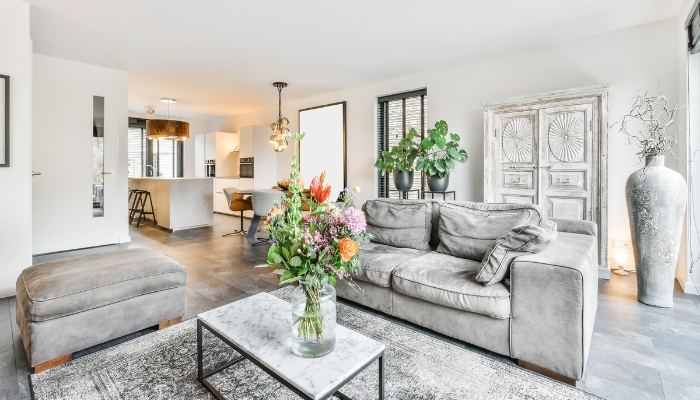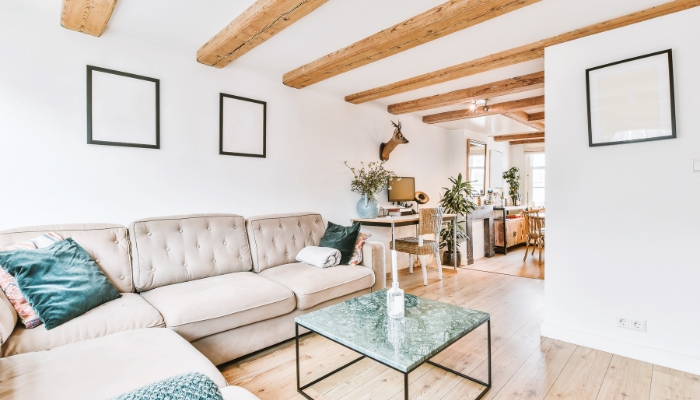Every room tells a story, and the furniture is the cast of characters that bring it to life. But just like in any good tale, placement matters. It's not just about having beautiful pieces; it's about arranging them to create harmony, encourage conversation, and simply feel right. Whether moving into a new space or just looking to refresh your current one, understanding the art of furniture arrangement can transform your home from ordinary to extraordinary. Let's dive into the world of focal points, flow, and the fine details that make a room shine.

The Beat of the Room: Understanding Focal Points
Every room has a story to tell, and the focal point is the headline that grabs your attention. It's that standout feature or element that draws the eye and sets the tone for the entire space. Think of it as the anchor around which everything else revolves.
Common focal points include:
- Fireplaces: These aren't just sources of warmth; they're the traditional heart of a room. Whether it's a grand stone mantle or a sleek modern design, fireplaces often become the natural gathering spot in a living space.
- Large Windows: Especially in homes with a view, large windows or French doors can serve as a room's focal point. They flood the space with natural light and provide a picturesque backdrop, be it a city skyline, a serene beach, or a lush garden.
- Art Pieces: A striking painting, sculpture, or even a wall of curated photographs can command attention. Art can evoke emotions, spark conversations, and reflect the homeowner's personality when chosen thoughtfully.
- Entertainment Centers: A large TV or entertainment center can be the focal point in modern homes, especially where technology plays a central role. The key is to integrate it seamlessly, ensuring it doesn't overpower the room but complements its design.
Identifying the focal point is the first step in effective furniture arrangement. Once you've pinpointed it, you can position your furniture to highlight and complement this feature, ensuring that the room feels harmonious and inviting.
Harmonizing Spaces: Creating Conversational Areas
Conversations are the heartbeat of any social gathering, and how you arrange your furniture can either facilitate lively chats or hinder them. Creating conversational areas fosters intimacy, ensures comfort, and promotes interaction.
A conversational area is a space where people can sit and talk without straining their necks or raising their voices. It's where stories are shared, laughs are had, and memories are made.
When creating your space, here are some things to consider:
- Distance Matters: Ideally, seating should be placed no more than 8 feet apart to promote easy conversation. Too close, and it feels cramped; too far, and it hinders interaction.
- Face-to-Face: Whenever possible, arrange seating to face each other. This not only promotes direct conversation but also creates a more intimate setting.
- Mix and Match: Incorporate a mix of sofas, armchairs, and occasional chairs. This not only adds visual interest but also offers guests a choice of where they'd like to sit.
- Table Talk: Including a coffee table or side tables within reach ensures guests have a place to set their drinks or snacks. It also provides a central area around which conversation can revolve.
- Avoid the 'Theater' Setup: While it might be tempting to line up all your furniture facing the TV or fireplace, this can stifle conversation. Instead, consider angling chairs or using versatile furniture pieces that can be easily moved when needed.
Remember, the goal is to create a warm and welcoming environment where guests feel at ease. By setting up dedicated conversational areas, you're not just arranging furniture; you're setting the stage for meaningful connections and memorable moments.

Smooth Moves: Optimizing Traffic Flow
Navigating through a room should feel like a smooth waltz, not an obstacle course. The way you position your furniture plays a pivotal role in ensuring easy movement and accessibility within any space. Let's dive into the art of optimizing traffic flow.
Imagine the pathways in your room as dance routes. They should be clear, intuitive, and free from interruptions, allowing people to move gracefully from one point to another.
Here are some general strategies to follow:
- Clear Pathways: Ensure that there are clear and direct paths to key areas like doors, windows, or hallways. A good rule of thumb is to maintain at least 2-3 feet of walking space between furniture pieces.
- Avoid Entryway Blockages: The entrance to any room sets the tone. Avoid placing large furniture pieces directly in front of doorways. Instead, create an inviting 'entry zone' with smaller items like a console table or a decorative bench.
- Centralize Bulky Items: Larger furniture pieces, like sofas or dining tables, work best when placed centrally in a room. This allows for a more balanced look and ensures they don't block any primary pathways.
- Use Rugs Wisely: Rugs can help define spaces and guide traffic. Place them in a way that they either encompass a seating area or run parallel to a pathway, guiding movement.
- Mind the Corners: Corners can often become choke points, especially in smaller rooms. Avoid cramming them with furniture. Instead, opt for pieces that fit comfortably without obstructing movement.
By prioritizing traffic flow in your furniture arrangement, you not only make your space more functional but also create an environment that feels open, relaxed, and inviting. After all, a well-thought-out room is one where you can move with ease and enjoy every corner without a hitch.

Striking the Right Chord: Balancing Proportions and Symmetry
In the world of interior design, balance is the unsung hero that brings harmony to a room. It's the invisible thread that ties everything together, ensuring that spaces feel cohesive, comfortable, and aesthetically pleasing. Let's delve into the art of balancing proportions and achieving that sought-after symmetry.
Balance in design is akin to a seesaw. When elements on both sides are evenly distributed, everything feels right. But if one side is overloaded, the whole room can feel off-kilter.
Try some of these strategies next time you're reorganizing:
- Mix and Match: Combine larger, heavier furniture pieces with smaller, lighter ones. For instance, if you have a bulky sofa on one side of the room, balance it out with a pair of accent chairs or a sleek coffee table on the opposite side.
- Vertical Balance: Don't just think horizontally. Consider the vertical space by mixing tall items like bookshelves or floor lamps with lower pieces such as coffee tables or ottomans.
- Symmetry vs. Asymmetry: While symmetrical arrangements (where items mirror each other on either side of a central point) exude formality and order, asymmetrical setups can bring dynamism and interest. Both have their merits, so choose based on the vibe you want to achieve.
- Play with Scale: Introduce a variety of sizes in your decor items. For instance, a large wall clock can be balanced with a cluster of smaller framed photos or artworks.
Achieving balance doesn't mean everything has to match perfectly. It's about creating a sense of equilibrium that feels right to the eye and soul. By paying attention to proportions and symmetry, you can craft spaces that are both functional and beautifully harmonized.

Setting the Stage: Enhancing the Overall Look
The final touch in furniture arrangement is all about the details. While the primary pieces set the stage, it's the accents and finishing touches that truly bring a room to life. Let's explore how to elevate your space, making it not just functional but also a reflection of your personal style.
Accents are like the jewelry of a room. They might be small, but they pack a punch in terms of style and personality.
We've got some key strategies that you can implement in your home:
- Color Cohesion: Introduce a consistent color palette. Whether it's through throw pillows, rugs, or art, having a harmonious color scheme can tie everything together and elevate the room's look.
- Layering Textures: Mix materials and textures to add depth. A velvet sofa, a cute rug, and a glossy coffee table can coexist beautifully, offering tactile and visual variety.
- Functional Decor: Think of decor that also serves a purpose. A decorative bowl can hold keys, a beautiful tray can organize remotes, and a stylish basket can store blankets.
- Lighting Magic: Lighting can dramatically change the mood of a room. Use a mix of overhead lights, floor lamps, and table lamps to create ambiance. Consider dimmers for added flexibility.
- Greenery: Plants breathe life into a room. Whether it's a large potted plant, a few succulents, or fresh flowers, they add a touch of nature and a splash of color.
- Mirrors: Not only do they reflect light and make spaces feel larger, but mirrors can also be decorative pieces in their own right. Choose frames that complement your room's style.
Remember, while guidelines can steer you in the right direction, there's no one-size-fits-all in design. Trust your instincts, play around, and most importantly, create a space where you love to spend time. After all, your home should be a reflection of you!
The journey of arranging furniture is akin to piecing together a puzzle. Each item, from the largest sofa to the smallest decor accent, has its place. And when everything fits just right, the result is a cohesive, inviting space that feels both functional and fabulous. Remember, while guidelines and tips are great starting points, your home should resonate with your personal touch. So, trust your gut, and when you're ready to experiment a little and create a sanctuary that's uniquely yours, stop on by!